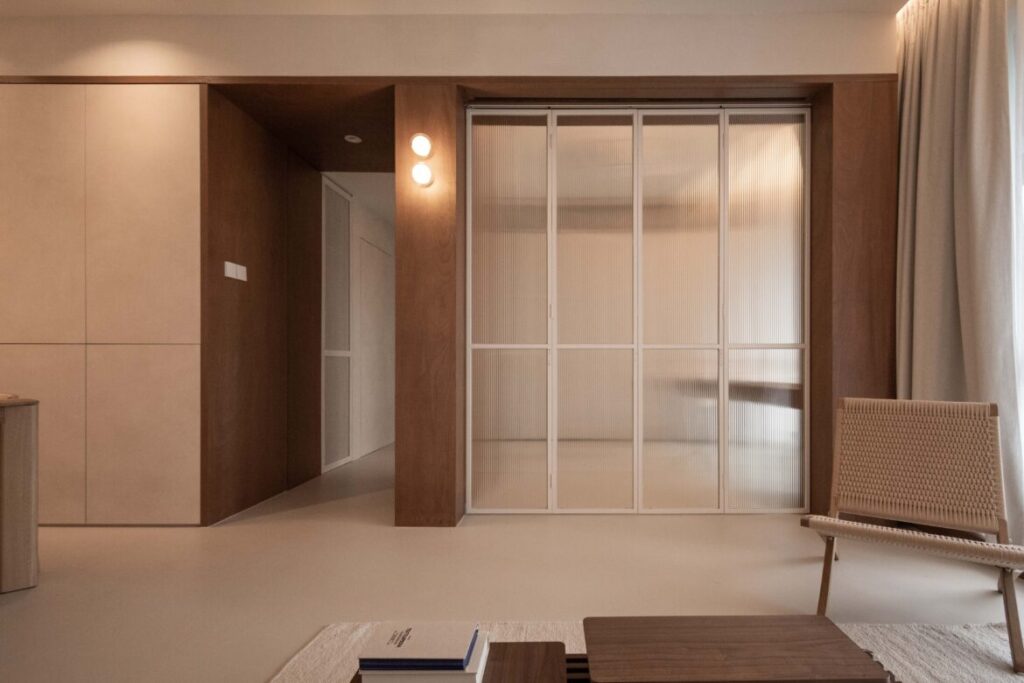Find out exactly what microcement is, the advantages and drawbacks, and whether it’s right for your needs.
26 September 2023
Top image: Design by Quarters Architects
Text by Lookbox Living
The term ‘microcement’ is one that’s increasingly mentioned in the world of interior design, having gained popularity for its versatility, durability and contemporary aesthetics.
For many, microcement surfaces look rather like cement screed, which leads to some confusion. So what exactly is this material?
Microcement, also known as microtopping or microconcrete, is essentially a composite material made primarily of cement, along with polymers, fine aggregates, and sometimes pigments. The result is a thin, versatile overlay of less than 3mm that can be applied over existing surfaces like concrete, tiles, wood or even walls and countertops that are in decent condition – thus minimising the need for heavy renovation works.
Cement screed is known to chip and crack, and is also quite porous if not properly sealed. Microcement on the other hand, is generally considered more durable than cement screed, with higher levels of resistance to cracking and other forms of damage. It can also be applied to a wider range of surfaces and is available in a wider selection of colours and textures to help you achieve a custom look.

Versatility: One of the most significant advantages of microcement flooring is its incredible versatility. It can be applied to a wide range of surfaces, including floors, walls, countertops, and even furniture. This adaptability makes it an excellent choice for achieving a cohesive, contemporary look throughout your space.
Durability: Microcement is highly resistant to wear and tear, making it an ideal flooring option for high-traffic areas. When properly installed and sealed, it can withstand heavy foot traffic, making it suitable for both residential and commercial settings.
Waterproof and Stain-Resistant: When adequately sealed, microcement becomes waterproof and stain-resistant. This is particularly valuable in spaces like kitchens and bathrooms, where spills are common. It simplifies cleaning and maintenance while preserving the beauty of the floor.
Aesthetic Customisation: Microcement comes in a wide range of colours, allowing for endless customisation possibilities. Whether you prefer a minimalist, industrial look or a more vibrant and colourful design, microcement can accommodate your vision.
Sleek Appearance: The seamless finish of this material creates a sleek and modern appearance. It lacks the grout lines or seams that can disrupt the visual continuity of traditional flooring materials like tiles.
Easy Maintenance: Microcement floors are relatively easy to maintain. Regular sweeping or vacuuming to remove dust and debris, along with periodic mopping using a pH-neutral cleaner, is usually sufficient to keep the surface clean and looking its best.
Eco-Friendliness: Microcement is an environmentally friendly choice when compared to some other flooring materials, as it typically has a lower carbon footprint and fewer VOC emissions.

Professional Installation Required: One of the drawbacks of microcement is that it demands professional installation. The application process requires precision, skill, and experience. DIY attempts can result in an uneven finish, which can be challenging to rectify.
Cost: Microcement tends to be more expensive than traditional flooring options like tiles and vinyl. The higher cost is attributed to the specialised materials and labour-intensive installation process.
Drying Time: After installation, microcement floors require adequate curing time, typically a few days, during which the area cannot be used. This can be an inconvenience during construction or renovation projects.
Potential for Cracks: Like concrete, microcement can develop cracks if the substrate it’s applied to is not properly prepared or if there is movement or settling in the underlying structure. While these cracks can be repaired, it’s essential to ensure a stable substrate.
Limited DIY Potential: While some homeowners may be inclined to tackle DIY projects, microcement installation is not beginner-friendly. The complexity of the process, along with the need for specialised tools and materials, makes it better suited for professional installers.

Proper maintenance is essential to preserve the beauty and longevity of microcement floors. Here are some maintenance tips:
Regular Cleaning: Sweep or vacuum the floor regularly to remove dust and debris that can cause surface abrasions over time.
Prompt Spill Cleanup: Accidents happen, but it’s crucial to wipe up spills promptly to prevent staining. Microcement is stain-resistant when sealed, but prolonged exposure to certain substances can lead to discolouration.
Sealing: Depending on the level of traffic and wear, microcement floors may require periodic resealing. This process helps maintain their waterproof and stain-resistant properties.
Avoid Harsh Cleaners: Use a pH-neutral cleaner and a soft mop or cloth when cleaning your microcement floors. Avoid harsh chemicals or abrasive cleaning methods, as they can damage the surface finish.
Protective Measures: To prevent scratching, consider placing protective felt pads on the feet of furniture, especially in high-traffic areas.
While professional installation and a higher upfront cost may deter some, the benefits of microcement, such as waterproofing, stain resistance, and ease of maintenance, often outweigh these drawbacks. If you’re looking to elevate the style and functionality of your space, microcement could be the modern marvel you’ve been searching for.
We think you may also like Wabi-sabi: How to incorporate this philosophy and style into your home
Like what you just read? Similar articles below

A couple’s dream of laid-back, resort-style living is beautifully realised in this HDB flat, and on a tight budget too.

Art and functionality converge tastefully in this beautifully curated HDB flat designed by MynMyn Studio.